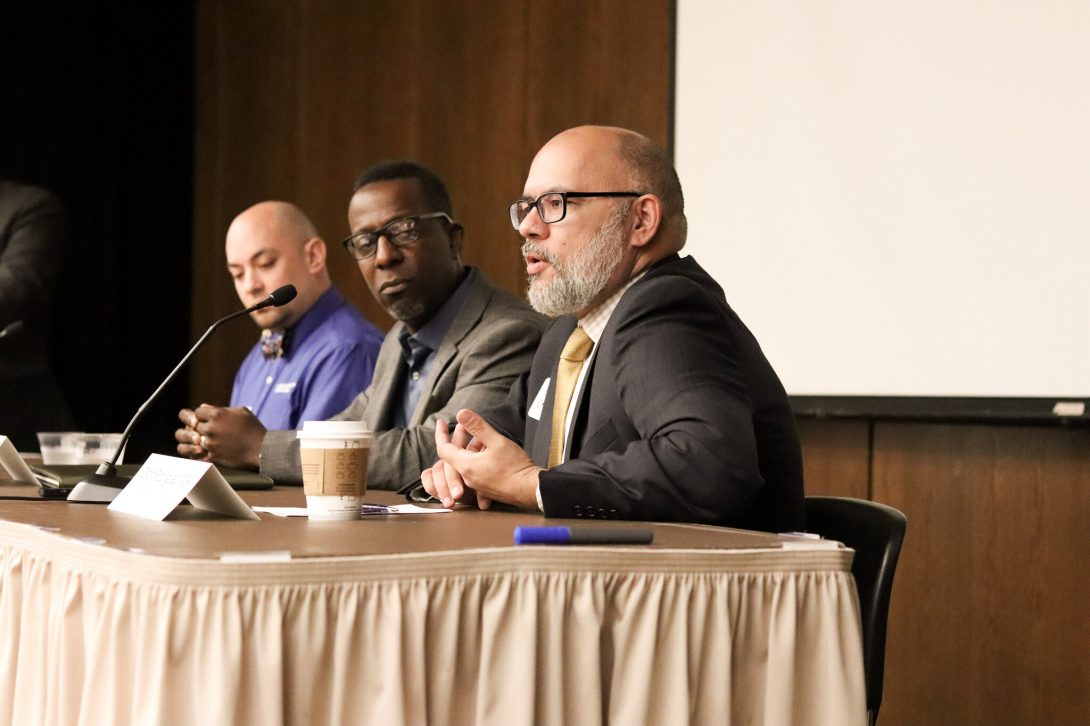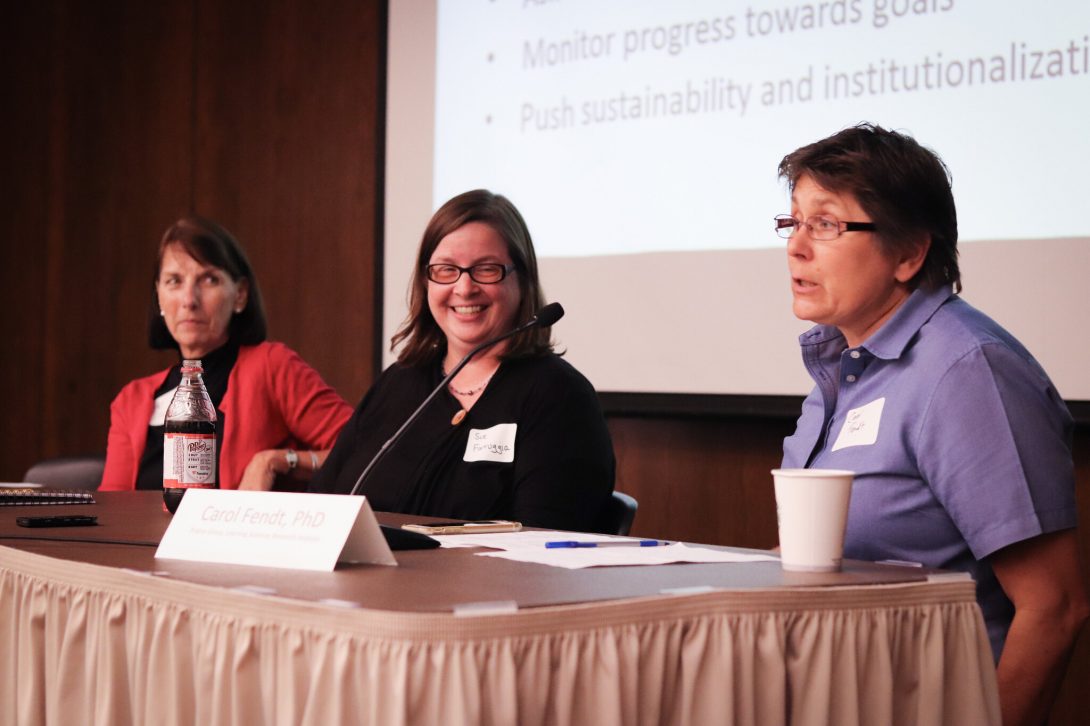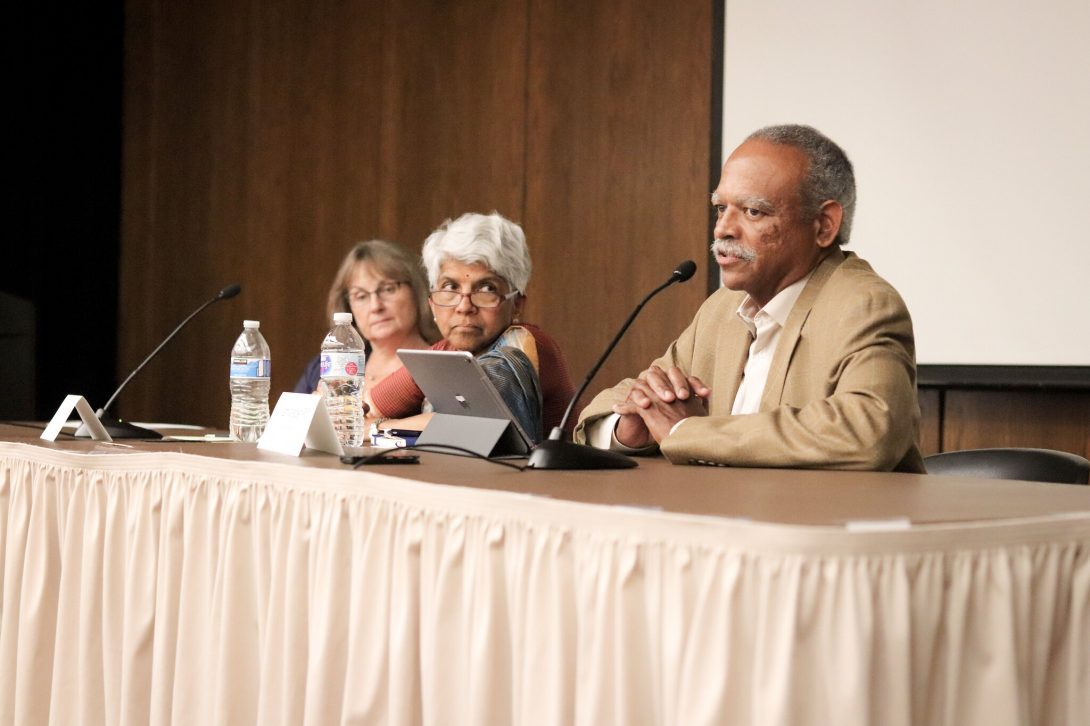STRategies for Inclusion, Diversity and Equity
Introduction
STRIDE is a network that brings together grant-based and institutional pipeline programs with academic support, student life, and cultural programs and centers. We seek to learn from each other and work together to broaden and deepen our efforts to serve our diverse body of students at UIC.
Get the Flyer - Download Here!
2019 theme
“As we have increased enrollment what does it mean for our ability to serve our students? How do we move from minority enrolling to minority serving? What are the specific challenges you would like to discuss regarding our mission of serving students with rapid growth and enrollment?”
2019 Conference
Time
Title
Speakers
8:15 a.m.
Breakfast Networking
9:00 a.m.
Welcome and Recap from 2018
Faculty Diversity Efforts and New Diversity Programs
Provost Susan Poser
Amalia Pallares, Karen Colley, Nancy Freitag
10:00 a.m.
Concurrent Workshops
10:45 a.m.
BREAK (pick up lunch)
11:00 a.m.
Plenary Presentation
Rosa Cabrera, Jordan “JT” Turner
11:30 a.m.
Small Group Breakout Discussion Sessions
12:30 p.m.
Wrap Up
Amalia Pallares, Karen Colley
12:45 p.m.
BREAK
1:00 p.m.
Concurrent Workshops
plenary
Centers for Cultural Understanding and Social Change – Rosa Cabrera (Director, Latino Cultural Center) & Jordan “JT” Turner (Director, Gender and Sexuality Center)
The first part of this session will provide an overview on various ways that the UIC cultural centers assist students to achieve success in their educational pursuits and professional and personal aspirations. The centers develop strategies and programmatic responses that consider the lived experience of students as they face challenging personal, community, and educational issues. During the second part, centers’ staff will facilitate small group discussions to explore how collaborations between different campus entities with the centers can advance student learning and success in creative and engaging ways.
How to develop a logic model for your program and how to use it for evaluating progress towards goals
Carol Fendt, Director, PRAIRIE Group, Learning Sciences Research Institute
Attendees will prepare a proposal, project, or program description to work on; this is a working session and not just a presentation. In this workshop attendees will develop a logic model for their program that links goals, program activities, and outcomes. Utilizing this logic model they will create evaluation questions to provide formative and summative feedback on the effectiveness and impact of their program. The goal is to leave with a logic model and an evaluation plan.
Creating Inclusive Classrooms: Small Strategies for Large Impacts
Charu Thakral, Associate Vice Provost for Diversity & Michelle Manno, Director for Diversity Initiatives
The Office of Diversity’s Inclusive Classroom Initiative (ICI) lives at the intersection of three key institutional pri¬orities at UIC: diversity, equity, and inclusion; student success; and teaching excel¬lence. The initiative is based on the understanding that effective, high-quality teaching considers what is taught (academic content), who is taught (the student), and how the material is delivered (pedagogy). Given that the tendency for many instructors is the sole focus on course content with a lack of attention to exploring the relationship between content, student identity/experience, and pedagogical practice, ICI provides strategies for an inclusive and equitable environment where students can succeed. This session will highlight some easily implementable, successful strategies used in existing ICI professional development modules. Through small group discussions, participants will explore inclusive practices in the classroom and discuss the ways in which they can impact student success.
Creating Mentor Training that Will Serve Multiple Programs at UIC: A Proposal
Karen Colley, Dean of the Graduate College and Professor of Biochemistry and Molecular Genetics, College of Medicine
As a minority serving university that is also a Highest Research Doctoral University, UIC is exceptional. UIC is also exceptional in that it has experienced an amazing increase in undergraduate enrollment over the last few years bucking a trend in Illinois and across the country. The faculty and staff at UIC are committed to serving our undergraduates, as well as all of our trainees, and we are especially sensitive to the needs of the minority members of our community. We have many pipeline and support programs, some funded by federal grants that require mentors to receive training. The Center for the Improvement of Mentored Experiences in Research (CIMER) has created a comprehensive mentor training program that is grounded in facilitated discussion of scenarios describing mentoring challenges. The downside of this program is that it is very time consuming. The challenge I have taken on is to create a general mentor training, based on the CIMER mentor training, that includes best practices and a variety of facilitated discussion scenarios that can be selected to best serve different audiences. I invite the experts who are already offering mentor training and those who aspire to offer mentor training to join me to provide feedback on my first attempt to create a 2-3 hour general mentor training that can be used as is or modified to serve a specific audience.
2018 quote
Should our aspirational goals be to not need these programs at some future date?
Inaugural 2018 Conference
Time
Title/Subtitle
Panelists
Moderator
8:00am
Breakfast and Pipeline Expo—
UIC Programs and Support Units
9:15
Opening Remarks
Amalia Pallares, Karen Colley
9:30
Session 1
Aixa Alfonso, Sara Hall
Maryfrances Miley
11:00
Provost Poser Remarks
11:15
Session 2
Jeff Alton, Jeff Brown, Oscar Rodriguez
Luis Duarte
12:30pm
Lunch
1:30
Session 3
Sue Farruggia, Carol Fendt, Pat Inman
Lunaire Ford
3:00
Session 4
Meena Rao, William Walden
Karen Colley
4:30
Closing Remarks
Karen Colley, Amalia Pallares
Incentivizing faculty to identify and pursue new grant opportunities

A culture change is needed. Don’t call it service—call it leadership!
UIC is encompassed by a large number of distinct urban communities and is recognized as a diverse center of learning for undergraduate students through MSI designations. What are the challenges and opportunities for faculty pursuing new pipeline grant programs that help promote student development and research? How do we get the institution to link the importance of diversity pipeline and support programs and grants to the UIC mission, better train and support faculty and staff in writing and leading these diversity pipeline and support grants, and reward those individuals?
- Continue RDS emails/website that highlight grant opportunities and expand to include private foundations that accept unsolicited applications.
- More meetings to bring faculty and staff together to discuss opportunities.
- Bootcamps, online modules, webinars, and grant writing specialists to assist diversity grant writers.
- Centralized repository of faculty and student information, key resources, templates, information, lists of “go to” people for all aspects of diversity grants.
- Host annual or quarterly STRIDE meetings to inform participants of upcoming opportunities, provide training, and bring interested parties together to collaborate.
- Elevate the stature of the training grant for P&T. Bring together Provost, VPFA, and diversity leadership to discuss an effort to encourage departments to include leadership (training grant writing and leadership) in these programs in their P&T norms.
- Course load reduction, financial reward (more ICR returned), high profile congratulatory email blast to acknowledge diversity efforts.
- Determine how UIC should institutionally prioritize certain areas to focus on for external grant writing, and to sustain or support other areas with institutional funds so that we don’t have to scramble to support these areas.
- Offer faculty and staff support and assistance on all levels, data repositories, training, expert grant writers, etc.
Recruitment and mentoring

Retention is the best recruitment strategy, and our students are the best ambassadors.
What are the best recruitment practices that are used to identify and recruit potential and current students who could benefit from new programming? In addition, mentoring is increasingly viewed as an essential tool in retaining students. What are effective mentoring practices and institutional mechanisms that can best support mentoring?
- What are the best practices for recruiting new diverse students?
- Start very early, and build relationships with elementary and middle school students, and communities.
- Approach families early and often and invite them to university events even before their children are thinking of applying to college.
- Frame “diversity” for recruitment broadly and communicate that their backgrounds and experiences are important for future learning.
- Find partners to reach more students and provide as much information early and often as possible.
- Use data to determine best practices and measure impact and devise new approaches.
- Retention is the best recruitment strategy and students are our best ambassadors. How we treat our students is key!
- How do we recruit students once they are here to pipeline and support programs?
- Create a marketing plan. Aggressively promote programs to students through huge posters, email blasts, social media, and at campus hot spots. Give them an opportunity to talk to you about the program and be specific on the benefits. Message should be clear and intentional.
- Focus on the purpose of every program. What do students want, what do they need, and what are their goals? Address community concerns and student interest in those issues.
- Utilize new and more effective modes of communication. Engage students to evaluate what works and what doesn’t and adapt. Keep improving, and don’t become stagnant in our approaches.
- What are the best practices for mentoring and training mentors for diverse students?
- Listen and validate students’ experiences and challenges.
- Engage another faculty or staff member when you feel out of your depth.
- Incorporate mentor training and diversity training as part of faculty orientation and revisit training programs periodically.
- Elevate social and emotional intellect and mentoring skills as important elements in hiring.
- Incentivize faculty to learn new teaching methods for diverse students.
- How can we help faculty and staff learn to mentor students for retention?
- Develop your own mentor core and build a cohort of mentor colleagues. Make sure that they feel valued.
- Create opportunities for students and mentors to learn together.
- Introduce mentors to support programs and services across the campus so that they can more easily make referrals.
- Use support programs and service centers to recognize the importance of diversity in the student identity.
- Recognize the importance of peer mentors (UG-UG) and near-peer (UG-Grad) mentoring relationships.
Student and program assessment practices

It’s important if we’re hearing the same feedback from different sources.
Describe how information is gathered and analyzed in order to identify prospective students and monitor their progress and outcomes after program completion and graduation. What are the current options for assessment and tracking, and what challenges remain?
- What internal and external data are available to help identify students in need of support? What data are available to aid in recognizing elements of student success?
- The Common App and Entering Student Survey create a student profile and provide data on student college choices. Very roughly, we admit 65% of those who apply and 35% of those enroll. We lose those who don’t enroll.
- What courses do our students take, and do they persist? We lose 20% of our students in the first year.
- A program of early alerts started in 2012 to aid advisors with early intervention; 45 courses participated in Fall 2017.
- Data on non-cognitive strengths of students (about 90% of first-year students) have been collected since 2015 and shared with advisors to provide more specialized support for individual students.
- External data sources include the National Student Clearinghouse (NSC), NSF Survey of Earned Doctorates, and IPEDS. Social media, individual contacts, and surveys provide additional data.
- Career Services has merged NSC data plus social media (like LinkedIn) data to track where students go after graduation.
- Utilize external data, e.g., high school identity, to build UIC programs. This information allows programs to evaluate the context from which students were educated. Illinois State Report Card data has information on specific high schools; To&Through Project provides more information at individual HS level.
- Record in Banner student affiliation with multiple programs to recognize students who might need more support; approximately 40% of incoming students don’t have a secondary affiliation (touchpoint) beyond their academic college.
- What are the best practices for tracking alumni?
- Initiate exit interviews and surveys.
- Engage and attract more alumni through alumni association events to remain in contact with UIC rather than track them. Establish an “open” alumni association and engage alumni through events for recruitment and mentoring.
- Train students to use LinkedIn to help with tracking and establish an ongoing updated alumni directory.
- How can we influence more east campus undergraduates to explore graduate and professional school options on the west campus?
- For first generation students, it’s not typically on their radar, so explore those options early. Utilize alumni from graduate and professional schools to attract undergraduate alumni and talk about options.
- Regular program assessment can provide valuable information for program improvement. What are the best ways to implement program assessment?
- Develop a logic model and revisit this model to track progress.
- Always think carefully about milestones and benchmarks at the very beginning.
- Engage an assessment professional or identify an individual to take on that assessment task.
- Implement surveys through focus groups and recognize the value of student feedback and narratives.
- Be intentional in the questions you ask and the information you seek.
- How will the data be analyzed, used, and disseminated? Develop methods to provide and share data. It’s important that if we are hearing the same things, that we pass it along.
- Identify the unintended outcomes from the data and survey analysis.
- Maintain connections with the stakeholders.
- Is the program sustainable? Assign responsibility to someone in each program to assess program and achieve sustainability.
- Establish formative data gathering surveys and focus groups throughout the program to assess whether you are achieving program goals.
- Recognize the value of success stories and testimonials (written and video) for assessment, training of staff, and orientation of new program cohorts.
- Avoid assessment and survey overkill.
- Be transparent, and recognize that change may be necessary, through different programming or personnel.
Institutionalization and sustainability of programs

Should our aspirational goals be to not need these programs at some future date?
Sustainability is a challenge for any university program, especially for those that do not have dedicated and permanent university funding. What are the features that highly successful institutionalized programs have in common?
- What are the differences between institutionalization and sustainability?
- Institutionalized programs are fundamental to and define the institution, whereas sustained programs often change with commitments of individuals or budget, e.g., SROP is a sustained program that is almost institutionalized.
- If a program is imbedded within the institution, then it is less likely to be cut with a change in leadership, unlike a sustained program, e.g., DFI, SROP.
- Additional example: Urban Health Program (UHP). UHP is a sustained program, since it presumably serves a sub-population rather than broad group of students.
- To move a program from sustained to institutionalized, it is important to communicate the value of the program by reporting its activities and outcomes. Assessment, communication, and broad engagement are essential in making the case.
- When do these types of program become obsolete? What programs should be institutionalized, or should our aspirational goals be to ultimately end these programs when equity has been achieved? For example, is the Chief Diversity Office necessary if true equity, diversity, and inclusion has been achieved throughout the institution?
- What about private partnerships? How can we reach out to industry?
- Seek individuals or corporations who wish to engage with the institution.
- At UMBC a private donor gave a gift to specifically educate African American males to be STEM doctoral graduates and become scientists in the Meyerhof Program; at UIC, NSF wanted to see corporate funding but private funding was more accessible.
- Be specific and cautious about public/private partnerships and expectations.
- Engage department heads and deans as charismatic leaders.
- How do you craft a grant proposal when there are concerns about sustainability?
- Assessment is the key to validating and sustaining a program.
- Scalability is important when you measure impact from a pilot project. Student retention can be translated to $11K/year/student as a benchmark.
- Resources in funding and staff are important to scale up a program.
- When pipeline programs are created, support from top leadership is crucial, e.g., Women in Science and support from Provost to garner NSF funding.
- What are adequate resources for program assessment?
- External evaluators are not always available or affordable, so look within institution.
- Provide graduate assistantships to help with program assessment through course credit or internships.
- Adapt the CUPPA mentoring program for other program assessments.